Science at UCMP : Research : Field notes : Lorraine Casazza
Pyramids, forams, and Red Sea reefs: Field notes from Lorraine Casazza
By former UCMP grad student Lorraine Casazza, July 5, 2012: A research summary
| Lorraine filed her Ph.D. dissertation this year (2012) and kindly sent us this research wrap-up from Morocco. Lorraine had visited Egypt on a Fulbright Fellowship to work on a coral reef monitoring method using foraminifera, and was granted a six-month extension to continue her work. Lorraine believes that the decline of coral reefs is a global problem that requires global solutions. Through international collaboration, scientists have the ability to bring cultures, and nations, together. |
July 5, 2012: A research summary
Wow — it's been four years since my last field note submission. I admit I was surprised when the UCMP asked me to do one more entry summing up the results of my work in Egypt, but of course research isn't really finished until the results are presented to the wider community. Now that I've completed my Ph.D. dissertation, I'm preparing manuscripts of my work and hopefully other researchers will be able to read all about the technical details of my projects in a peer-reviewed journal in the coming year. In the meantime I'll share some of my most interesting results and conclusions on a species of the genus Nummulites (those "mighty giants" of the single-celled world) and on the history of Red Sea coral reefs.
Symbiosis built the pyramids
One of the things I was doing in Egypt was searching for fossil shells of extinct Nummulites, the gigantic, single-celled marine organism that comprises the limestone blocks used to build the Pyramids. There is a long-standing hypothesis that Nummulites and some of their hugest, close relatives had algae living inside them in a very close, mutually dependent relationship we call symbiosis. My goal was to test this hypothesis by analyzing the chemistry of Nummulites shells. The shell chemistry could tell me if those algae had been present because algae perform photosynthesis, which changes the chemical make-up of shells in some taxonomic groups — including the one Nummulites belongs to.
In fact, searching for Nummulites in Egypt isn't so different from searching for sand in the Sahara Desert; nearly the entire country is made of them — or more specifically, from limestone rock composed of their shells. Every set of stairs, countertop and bathroom wall I encountered was full of Nummulites shells. But I couldn't use just any shells for my test. I needed to find shells that hadn't changed at all in the last 45 million years. As you can imagine, all kinds of things can happen to a shell in that amount of time, so while I had a wonderful time searching the desert outcrops of Egypt in search of pristine shells, I never actually found any.


The small inset picture at the lower left shows you the inside of a Nummulites gizehensis shell, and the bigger picture is a close up of what's inside that tiny white box. Click to see an enlargement of this SEM image. At such a small scale (10 µm is only about .0004 inches) you can see the crystals that make up the shell wall. To test for the presence of symbionts, I need to find specimens composed of their original, unaltered calcium carbonate. But in the roughly 42 million years since it died, this specimen has been exposed to fluids carrying minerals, and these have crystallized into a substance called dolomite. The graph at the right is an x-ray spectrum showing us that this mineral contains a lot of magnesium (Mg), which helps confirm that it's dolomite. Shells that have this kind of contamination can't be used for my study. |
That's where my friends and colleagues, Dr. Strougo and Dr. Boukhary of Ain Shams University come in. These guys have been studying Nummulites longer than I've been alive, and they had the collection of shells to prove it! After another fruitless expedition, Dr. Strougo pulled some very dusty boxes from his private collection, and after rummaging through more than a few he held up a small, perfect sample he and Dr. Boukhary collected from a clay pit in 1984. It contained a species of Nummulites called Nummulites gizehensis, named for the Giza plateau where the Pyramids are located. It's one of the most common Nummulites found in the Pyramid building blocks. But that wasn't all! There were also several much smaller types of shells that could tell me about the chemistry of the water the Nummulites were living in. These were critical for the analysis I wanted to do because shell chemistry doesn't just change if there are symbionts doing photosynthesis inside, it also changes depending on the chemistry of the water it grows in. So without information about the water chemistry, it would be impossible to see if there was also a chemical difference because of symbionts doing photosynthesis.
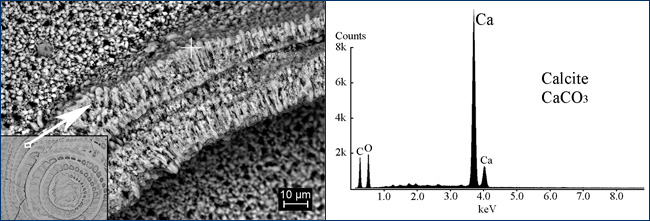

Like the previous image above, the small inset picture shows you the inside of a Nummulites gizehensis shell, and the bigger picture is a close up of what's inside that tiny white box. Click to see an enlargement of this SEM image. Based on this image, it looks like the shell wall may be unaltered calcium carbonate. The x-ray spectrum at right confirms that at least on the spot analyzed (where that white cross is on the picture) there's nothing but pure calcium carbonate present. This shell will give reliable results when I test for the presence of symbionts. |
Once I got this precious sample back to Berkeley, it was time to get to work. The first task was to really make sure that the shells I wanted to test were the same as when the Nummulites gizehensis were living on the bottom of the Tethys Sea 45 million years ago. I did this by using a scanning electron microscope to look closely at the physical structure of the shells, and by making maps of the different elements that were in them. If they were as pristine as I hoped they were, then I wouldn't see any changes to the shell shape — even at the smallest scale, and there wouldn't be anything except calcium, carbon and oxygen present in the shell. Once I knew I had original shell material on my hands, I was able to do an analysis of the carbon and oxygen atoms in the shell. If algal symbionts had lived in N. gizehensis then the numerical results would differ from the results for the other shells by a very particular amount. I ran the test multiple times on multiple specimens to make sure, and every time my results were the same; they fit the expected results for having algal symbionts living inside them.
Does this mean that symbiosis was the driving force for evolutionary changes in the size, complex shape and/or reproductive habits of Nummulites? We don't know, because this study only addresses one very specific question: did Nummulites gizehensis have algal symbionts? But through answering that question a whole set of new questions about the role of symbiosis in the evolution of this lineage can be asked.
Life after the coral-apocalypse
One of my other goals in Egypt was to survey the coral species that occur on fossil coral reefs that lived in the Red Sea around 125,000 years ago, and 230,000 years ago. I wanted to compare the coral assemblages that lived during those time periods with each other, and also with the coral species that live in the Red Sea today in order to see how different or similar they are. It's an interesting question because in between these three time periods the Earth underwent dramatic climate change, with the expansion of glaciers, global cooling and falling sea level. The falling sea level led to the Red Sea being almost completely cut off from the Indian Ocean in the south. Without regular water exchange with the wider world's oceans, the Red Sea became super-salty, and other changes on land led to it becoming richer in nutrients. Other researchers have published an independent record of these conditions by looking at the communities of plankton that lived (and disappeared) during those periods, collected from deep sea cores. These are conditions that kill corals — and a lot of other things too. So when conditions got good again for coral reef growth, were the new coral reef communities different than the ones that had come before? Most importantly, what if anything can we learn from the history of the Red Sea that might help us understand how to preserve coral reefs in the future as global climate change progresses?
Other researchers studying fossil coral reefs have found that in fact, coral reef communities don't really change across these glaciations. However, they were looking at reefs in Papua New Guinea and the Caribbean, which didn't experience the same extreme conditions that occurred in the Red Sea. The environmental catastrophe (from the perspective of a coral!) that took place during low sea level meant that corals went extinct over at least two-thirds of the Red Sea. Even in the areas closest to the narrow channel connecting the Red Sea to the Indian Ocean, conditions would have been deadly for most corals; only a few hearty species could have survived there. That means almost the entire Sea would have to be recolonized from scratch — surely there would be some big differences each time a recolonization took place.
But my results surprised me. At first glance the younger fossil corals looked different than the older ones, but being exposed to wind and rain for such a long period of time can alter the appearance of a fossil so much they aren't recognizable. Luckily most corals have massive skeletons, and if you cut into them you'll find areas that have been protected from the elements and still have the features that make them recognizable. Once I was able to accurately identify the older, weathered corals, it turned out the older fossil coral reefs weren't really any different than the younger ones, and both of them looked like the coral reefs that grow in the Red Sea today. There were differences between the sites I surveyed, but those differences had to do with the kind of reef environment they preserved, not the time period they lived during. For example some of the sites were shallow lagoons with calm water, while others were steep slopes exposed to lots of waves, and different kinds of species live in those different areas. But once I compared a group of fossils that lived in a lagoon to the corals that live in Red Sea lagoons today, they were the same.
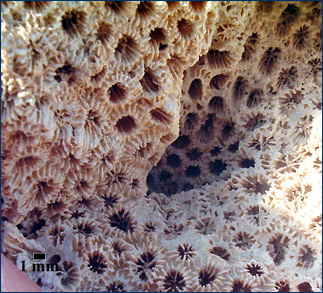 |
 |
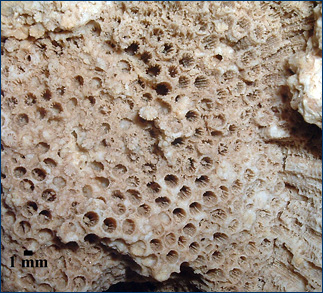 |

Click any of the next four images to see enlargements. Left: This is Favia stelligera, a coral species that's really common on reefs in the Red Sea today, and also really common on reefs around 125,000 and 230,000 years ago. This particular specimen lived around 125,000 years ago, and it was easy to identify it based on the size, shape and arrangement of all those little holes and the skeletal elements in and around them. Those holes are called corallites, and when a coral is alive, a tiny coral polyp lives inside each one of these. Right: This is also Favia stelligera, but this specimen lived 230,000 years ago. You can see that it doesn't look very much like the F. stelligera on the left; the corallites look bigger and more irregularly shaped, and the skeletal elements around them are mostly gone. Erosion from wind and rain have made this specimen difficult to recognize. |
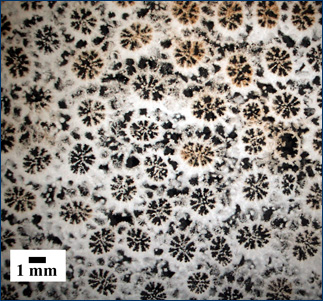 |
 |
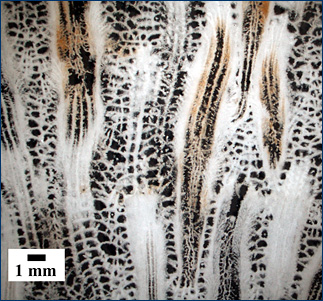 |

Left: I used a rock saw to cut through the older specimen in the previous figure, and took a slice from the interior of the skeleton. Then I used epoxy to attach it to a clear glass slide and polished it until I had this cross section to examine. The corallites were much less weathered away from the surface, and I was able to identify this coral as F. stelligera. Right: This is also a thin section from the older specimen in the previous figure, but this is an up-down slice (longitudinal) instead of an across slice (equatorial). This provides another view of skeletal elements to help identify the coral. |
What lessons can we learn from the tumultuous history of coral reefs in the Red Sea? The good news is that if seas return to the warm, clear, nutrient-poor conditions corals love — and there are any corals to do the recolonizing — coral reefs will return to their former glory. The key is that there have to be some places where corals can persist. In biology, we call these places refugia — small, isolated areas where populations can survive until conditions change again and they can spread back out. In the Red Sea, the far south may have acted as a refugium for some of the heartiest species, which also happen to be some of the most important founding species for settling new reefs. We still don't really know how big these refugia need to be, or how many of them would be needed to preserve all or most of the world's coral species during a prolonged period of extreme climate change. Even so, these marvelous animals are more resilient over geologic time than they sometimes seem on shorter times scales, and I hope that means they will have a place in our future's oceans.





